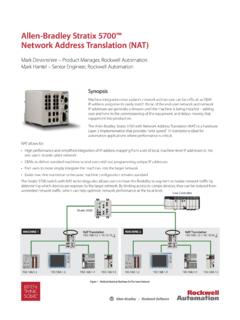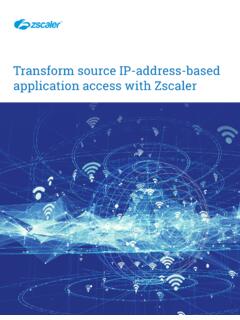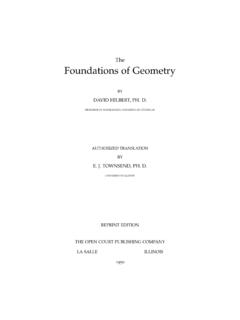Transcription of A arXiv:1409.0473v7 [cs.CL] 19 May 2016
1 Published as a conference paper at ICLR 2015 NEURALMACHINETRANSLATIONBYJOINTLYLEARNIN G TOALIGN ANDTRANSLATED zmitry BahdanauJacobs University Bremen, GermanyKyungHyun ChoYoshua Bengio Universit e de Montr ealABSTRACTN eural machine translation is a recently proposed approach to machine transla-tion. Unlike the traditional statistical machine translation , the neural machinetranslation aims at building a single neural network that can be jointly tuned tomaximize the translation performance. The models proposed recently for neu-ral machine translation often belong to a family of encoder decoders and encodea source sentence into a fixed-length vector from which a decoder generates atranslation. In this paper, we conjecture that the use of a fixed-length vector is abottleneck in improving the performance of this basic encoder decoder architec-ture, and propose to extend this by allowing a model to automatically (soft-)searchfor parts of a source sentence that are relevant to predicting a target word, withouthaving to form these parts as a hard segment explicitly.
2 With this new approach,we achieve a translation performance comparable to the existing state-of-the-artphrase-based system on the task of English-to-French translation . Furthermore,qualitative analysis reveals that the (soft-)alignments found by the model agreewell with our machine translationis a newly emerging approach to machine translation , recently proposedby Kalchbrenner and Blunsom (2013), Sutskeveret al.(2014) and Choet al.(2014b). Unlike thetraditional phrase-based translation system (see, , Koehnet al., 2003) which consists of manysmall sub-components that are tuned separately, neural machine translation attempts to build andtrain a single, large neural network that reads a sentence and outputs a correct of the proposed neural machine translation models belong to a family ofencoder decoders(Sutskeveret al.)
3 , 2014; Choet al., 2014a), with an encoder and a decoder for each lan-guage, or involve a language-specific encoder applied to each sentence whose outputs are then com-pared (Hermann and Blunsom, 2014). An encoder neural network reads and encodes a source sen-tence into a fixed-length vector. A decoder then outputs a translation from the encoded vector. Thewhole encoder decoder system, which consists of the encoder and the decoder for a language pair,is jointly trained to maximize the probability of a correct translation given a source potential issue with this encoder decoder approach is that a neural network needs to be able tocompress all the necessary information of a source sentence into a fixed-length vector.
4 This maymake it difficult for the neural network to cope with long sentences, especially those that are longerthan the sentences in the training corpus. Choet al.(2014b) showed that indeed the performance ofa basic encoder decoder deteriorates rapidly as the length of an input sentence order to address this issue, we introduce an extension to the encoder decoder model which learnsto align and translate jointly. Each time the proposed model generates a word in a translation , it(soft-)searches for a set of positions in a source sentence where the most relevant information isconcentrated. The model then predicts a target word based on the context vectors associated withthese source positions and all the previous generated target words.
5 CIFAR Senior Fellow1 [ ] 19 May 2016 Published as a conference paper at ICLR 2015 The most important distinguishing feature of this approach from the basic encoder decoder is thatit does not attempt to encode a whole input sentence into a single fixed-length vector. Instead, it en-codes the input sentence into a sequence of vectors and chooses a subset of these vectors adaptivelywhile decoding the translation . This frees a neural translation model from having to squash all theinformation of a source sentence, regardless of its length, into a fixed-length vector. We show thisallows a model to cope better with long this paper, we show that the proposed approach of jointly learning to align and translate achievessignificantly improved translation performance over the basic encoder decoder approach.
6 The im-provement is more apparent with longer sentences, but can be observed with sentences of anylength. On the task of English-to-French translation , the proposed approach achieves, with a singlemodel, a translation performance comparable, or close, to the conventional phrase-based , qualitative analysis reveals that the proposed model finds a linguistically plausible(soft-)alignment between a source sentence and the corresponding target : NEURALMACHINETRANSLATIONFrom a probabilistic perspective, translation is equivalent to finding a target sentenceythat max-imizes the conditional probability ofygiven a source sentencex, ,arg maxyp(y|x). Inneural machine translation , we fit a parameterized model to maximize the conditional probabilityof sentence pairs using a parallel training corpus.
7 Once the conditional distribution is learned by atranslation model, given a source sentence a corresponding translation can be generated by searchingfor the sentence that maximizes the conditional , a number of papers have proposed the use of neural networks to directly learn this condi-tional distribution (see, , Kalchbrenner and Blunsom, 2013; Choet al., 2014a; Sutskeveret al.,2014; Choet al., 2014b; Forcada and Neco, 1997). This neural machine translation approach typ-ically consists of two components, the first of which encodes a source sentencexand the seconddecodes to a target sentencey. For instance, two recurrent neural networks (RNN) were used by(Choet al., 2014a) and (Sutskeveret al., 2014) to encode a variable-length source sentence into afixed-length vector and to decode the vector into a variable-length target being a quite new approach, neural machine translation has already shown promising al.
8 (2014) reported that the neural machine translation based on RNNs with long short-term memory (LSTM) units achieves close to the state-of-the-art performance of the conventionalphrase-based machine translation system on an English-to-French translation neuralcomponents to existing translation systems, for instance, to score the phrase pairs in the phrasetable (Choet al., 2014a) or to re-rank candidate translations (Sutskeveret al., 2014), has allowed tosurpass the previous state-of-the-art performance ENCODER DECODERHere, we describe briefly the underlying framework, calledRNN Encoder Decoder, proposed byChoet al.(2014a) and Sutskeveret al.(2014) upon which we build a novel architecture that learnsto align and translate the Encoder Decoder framework, an encoder reads the input sentence, a sequence of vectorsx= (x1, ,xTx), into a most common approach is to use an RNN such thatht=f(xt,ht 1)(1)andc=q({h1, ,hTx}),whereht Rnis a hidden state at timet, andcis a vector generated from the sequence of thehidden some nonlinear functions.
9 Sutskeveret al.(2014) used an LSTM asfandq({h1, ,hT}) =hT, for mean by the state-of-the-art performance, the performance of the conventional phrase-based systemwithout using any neural network-based most of the previous works (see, , Choet al., 2014a; Sutskeveret al., 2014; Kalchbrenner andBlunsom, 2013) used to encode a variable-length input sentence into afixed-lengthvector, it is not necessary,and even it may be beneficial to have avariable-lengthvector, as we will show as a conference paper at ICLR 2015 The decoder is often trained to predict the next wordyt given the context vectorcand all thepreviously predicted words{y1, ,yt 1}. In other words, the decoder defines a probability overthe translationyby decomposing the joint probability into the ordered conditionals:p(y) =T t=1p(yt|{y1, ,yt 1},c),(2)wherey=(y1, ,yTy).
10 With an RNN, each conditional probability is modeled asp(yt|{y1, ,yt 1},c) =g(yt 1,st,c),(3)wheregis a nonlinear, potentially multi-layered, function that outputs the probability ofyt, andstisthe hidden state of the RNN. It should be noted that other architectures such as a hybrid of an RNNand a de-convolutional neural network can be used (Kalchbrenner and Blunsom, 2013).3 LEARNING TOALIGN ANDTRANSLATEIn this section, we propose a novel architecture for neural machine translation . The new architectureconsists of a bidirectional RNN as an encoder (Sec. ) and a decoder that emulates searchingthrough a source sentence during decoding a translation (Sec. ). : GENERALDESCRIPTIONx1x2x3xT+ t,1 t,2 t,3 t,Tyt-1yth1h2h3hTh1h2h3hTst-1stFigure 1: The graphical illus-tration of the proposed modeltrying to generate thet-th tar-get wordytgiven a sourcesentence(x1,x2.)

![arXiv:0706.3639v1 [cs.AI] 25 Jun 2007](/cache/preview/4/1/3/9/3/1/4/b/thumb-4139314b93ef86b7b4c2d05ebcc88e46.jpg)

![arXiv:1301.3781v3 [cs.CL] 7 Sep 2013](/cache/preview/4/d/5/0/4/3/4/0/thumb-4d504340120163c0bdf3f4678d8d217f.jpg)
![@google.com arXiv:1609.03499v2 [cs.SD] 19 Sep 2016](/cache/preview/c/3/4/9/4/6/9/b/thumb-c349469b499107d21e221f2ac908f8b2.jpg)










![[Your parent(s)/legal guardian(s) address] Entry Clearance ...](/cache/preview/d/a/4/2/8/2/9/3/thumb-da428293fc86d7e7b8cebe1132189c1a.jpg)
